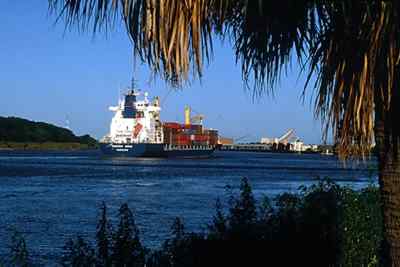 Savannah’s
Harbor and Cargo Ships
Savannah’s
Harbor and Cargo Ships  Savannah’s
Harbor and Cargo Ships
Savannah’s
Harbor and Cargo Ships The Port of Savannah is the nation’s 10th busiest container ship port, and is directly or indirectly responsible for about 70,000 jobs, according to the Ports Authority. In 1998, approximately 1,500 container ships moved close to 9 million tons of goods and materials through the port.
The Savannah River, which normally is 24 feet deep, has experienced three major dredgings with a fourth proposed for the future. Each dredging has affected the fresh water-salt water composition of the river, impacting the flora and fauna of surrounding marshes. In 1896, the 24-foot-deep river channel was dredged and most obstructions were removed, including Civil War wrecks and blockade structures. In 1945, the Georgia Ports Authority was formed and the river was dredged to 38 feet. In 1994, the channel was deepened to 42 feet. Now plans are in the works to deepen it even more to 48 feet, or twice its normal depth.
Container ships became prevalent in the 1960s, and since then they have grown in size. In essence, the cargo ships stack the trailer part or “container” of a semitrailer truck that one sees on the highway. A 20-foot container unit, or TEU, is the industry term that refers to a standard 20-foot-long container. In the 1960s, the ships were smaller, with TEUs of 600 to 1,000, and could easily navigate the current depths of the Savannah River. But as worldwide trade has grown, so has the size of container ships, with current behemoths carrying 6,000 TEUs, or the equivalent of 6,000 semitrailers. These huge ships, longer than a 100-story building and as wide as a 14-story building, require a deeper harbor to land their cargo.
Read and add comments about this page